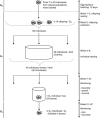Contrasting the distribution of phenotypic and molecular variation in the freshwater snail Biomphalaria pfeifferi, the intermediate host of Schistosoma mansoni
- PMID: 23321708
- PMCID: PMC3630815
- DOI: 10.1038/hdy.2012.115
Contrasting the distribution of phenotypic and molecular variation in the freshwater snail Biomphalaria pfeifferi, the intermediate host of Schistosoma mansoni
Abstract
Population differentiation was investigated by confronting phenotypic and molecular variation in the highly selfing freshwater snail Biomphalaria pfeifferi, the intermediate host of Schistosoma mansoni. We sampled seven natural populations separated by a few kilometers, and characterized by different habitat regimes (permanent/temporary) and openness (open/closed). A genetic analysis based on five microsatellite markers confirms that B. pfeifferi is a selfer (s≈0.9) and exhibits limited variation within populations. Most pairwise FST were significant indicating marked population structure, though no isolation by distance was detected. Families from the seven populations were monitored under laboratory conditions over two generations (G1 and G2), allowing to record several life-history traits, including growth, fecundity and survival, over 25 weeks. Marked differences were detected among populations for traits expressed early in the life cycle (up to sexual maturity). Age and size at first reproduction had high heritability values, but such a trend was not found for early reproductive traits. In most populations, G1 snails matured later and at a larger size than G2 individuals. Individuals from permanent habitats matured at a smaller size and were more fecund than those from temporary habitats. The mean phenotypic differentiation over all populations (QST) was lower than the mean genetic differentiation (FST), suggesting stabilizing selection. However, no difference was detected between QST and FST for both habitat regime and habitat openness.
Figures


Similar articles
-
Analysis of mating system, fecundity, hatching and survival rates in two Schistosoma mansoni intermediate hosts (Biomphalaria pfeifferi and Biomphalaria camerunensis) in Cameroon.Parasit Vectors. 2016 Jan 6;9:10. doi: 10.1186/s13071-015-1285-4. Parasit Vectors. 2016. PMID: 26739376 Free PMC article.
-
Low genetic diversity in a snail intermediate host (Biomphalaria pfeifferi Krass, 1848) and schistosomiasis transmission in the Senegal River Basin.Mol Ecol. 2010 Jan;19(2):241-56. doi: 10.1111/j.1365-294X.2009.04463.x. Epub 2009 Dec 15. Mol Ecol. 2010. PMID: 20025653
-
Spatio-temporal population genetic structure, relative to demographic and ecological characteristics, in the freshwater snail Biomphalaria pfeifferi in Man, western Côte d'Ivoire.Genetica. 2019 Feb;147(1):33-45. doi: 10.1007/s10709-018-0049-4. Epub 2018 Nov 29. Genetica. 2019. PMID: 30498954
-
Epigenetic modulation, stress and plasticity in susceptibility of the snail host, Biomphalaria glabrata, to Schistosoma mansoni infection.Int J Parasitol. 2016 Jun;46(7):389-94. doi: 10.1016/j.ijpara.2016.03.003. Epub 2016 Apr 4. Int J Parasitol. 2016. PMID: 27056272 Review.
-
Genetic variability and molecular identification of Brazilian Biomphalaria species (Mollusca: Planorbidae).Parasitology. 2001;123 Suppl:S197-209. doi: 10.1017/s0031182001008058. Parasitology. 2001. PMID: 11769284 Review.
Cited by
-
The genome and transcriptome of the snail Biomphalaria sudanica s.l.: Immune gene diversification and highly polymorphic genomic regions in an important African vector of Schistosoma mansoni.bioRxiv [Preprint]. 2023 Nov 2:2023.11.01.565203. doi: 10.1101/2023.11.01.565203. bioRxiv. 2023. Update in: BMC Genomics. 2024 Feb 19;25(1):192. doi: 10.1186/s12864-024-10103-w. PMID: 37961413 Free PMC article. Updated. Preprint.
-
Mating system of Biomphalaria sudanica, a vector of Schistosoma mansoni.Curr Res Parasitol Vector Borne Dis. 2025 Jan 6;7:100241. doi: 10.1016/j.crpvbd.2025.100241. eCollection 2025. Curr Res Parasitol Vector Borne Dis. 2025. PMID: 39877402 Free PMC article.
-
Population genetic structure of Bellamya aeruginosa (Mollusca: Gastropoda: Viviparidae) in China: weak divergence across large geographic distances.Ecol Evol. 2015 Oct 13;5(21):4906-19. doi: 10.1002/ece3.1673. eCollection 2015 Nov. Ecol Evol. 2015. PMID: 26640670 Free PMC article.
-
The genome and transcriptome of the snail Biomphalaria sudanica s.l.: immune gene diversification and highly polymorphic genomic regions in an important African vector of Schistosoma mansoni.BMC Genomics. 2024 Feb 19;25(1):192. doi: 10.1186/s12864-024-10103-w. BMC Genomics. 2024. PMID: 38373909 Free PMC article.
-
A genome sequence for Biomphalaria pfeifferi, the major vector snail for the human-infecting parasite Schistosoma mansoni.PLoS Negl Trop Dis. 2023 Mar 24;17(3):e0011208. doi: 10.1371/journal.pntd.0011208. eCollection 2023 Mar. PLoS Negl Trop Dis. 2023. PMID: 36961841 Free PMC article.
References
-
- Bell G. Selection: the Mechanism of Evolution. Oxford University Press; 2008.
-
- Bousset L, Henry P-Y, Sourrouille P, Jarne P. Population biology of the invasive freshwater snail Physa acuta approached through genetic markers, ecological characterization and demography. Mol Ecol. 2004;13:2023–2036. - PubMed
-
- Brown D.1994Freshwater Snails of Africa and Their Medical Importance2nd edn.Taylor and Francis Ltd: London
-
- Chapuis E, Trouve S, Facon B, Degen L, Goudet J. High quantitative and no molecular differentiation of a freshwater snail (Galba truncatula) between temporary and permanent water habitats. Mol Ecol. 2007;16:3484–3496. - PubMed
-
- Charbonnel N, Angers B, Razatavonjizay R, Bremond P, Jarne P. Microsatellite variation in the freshwater snail Biomphalaria pfeifferi. Mol Ecol. 2000;9:993–1011. - PubMed
Publication types
MeSH terms
LinkOut - more resources
Full Text Sources
Other Literature Sources
Molecular Biology Databases
Research Materials
Miscellaneous

